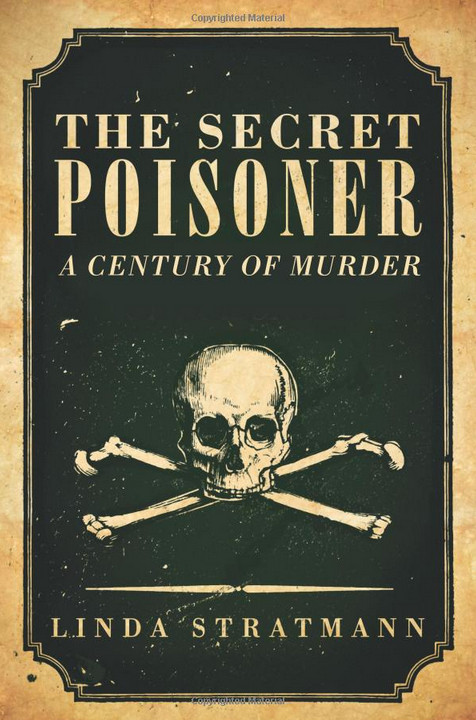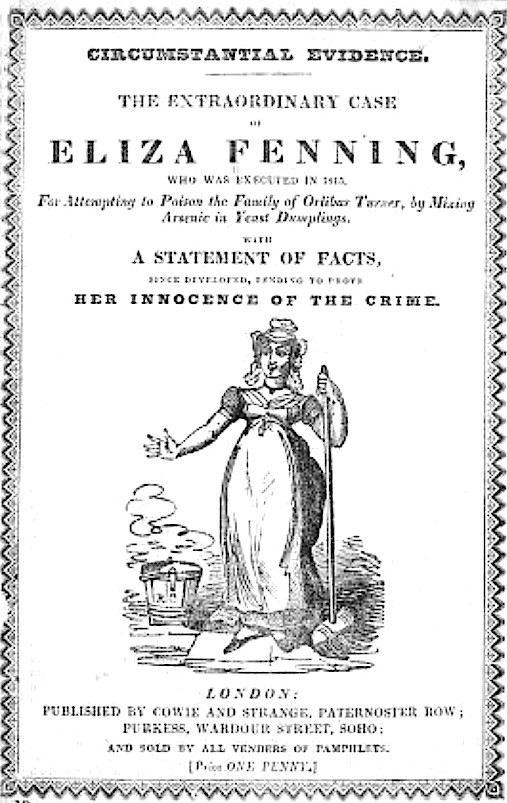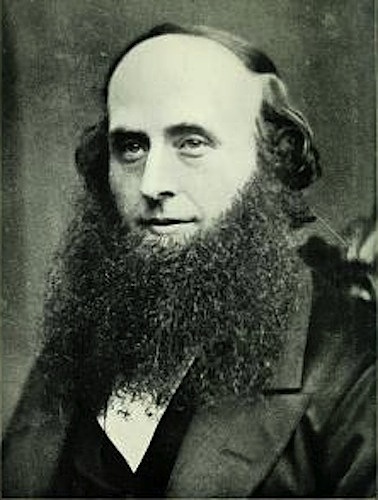An earlier version of this review appeared under the title of "The Acid Test" in the Times Literary Supplement (22 April 2016: 34). The author has reformatted and illustrated it for the Victorian Web, and added a few passages from the book by way of further illustration. Image sources are given at the end. Click on the pictures to enlarge them.

Sitters in Victorian photographs usually look quite solemn. Not so the women of the Pritchard family, in one of over thirty illustrations to Linda Stratmann's The Secret Poisoner. Mrs Pritchard and her mother both seem to be smiling, the former with one child on her lap, and four other children beside her. Her heavily bearded husband stands behind, one arm draped proprietarily on the back of her chair. But, as we later discover, Dr Pritchard was not exactly likeable, and those cheerful women would meet their doom at his hand. Stratmann is quite right to say in her Author's Note that The Secret Poisoner is not simply a collection of notorious cases. But cases like this do steal the show.

The first to come up is that of the young cook Eliza Fenning, hanged in 1815 on purely circumstantial evidence for having served "devilish dumplings" to the Taylor family. In this cause célèbre, everyone recovered except Eliza herself. Yet, in a sense, that was not the end of her. She haunts and helps to unify the rest of the book, the popular perception of her innocence indicating the need for more certainty in such cases. Stratmann goes on to explore, in well-documented detail, the processes by which toxicology and forensic science developed, producing a range of tests to detect poisoning. At the same time, she demonstrates that the perpetrators themselves became craftier, while the law struggled ever harder to keep up with advances on both fronts.
The problem was that people depended on potentially poisonous substances for cheap medicine and pesticides, at a time when there were no alternatives. For example, both Godfrey's Cordial for colicky babies, and Battley's sedative liquor for headaches, contained opiates, while arsenic, the substance most commonly used by poisoners, was indispensable for rat poison, sheep dips and other agricultural uses. Some less worthy use of poisons, such as "Quietners" containing antimony to check ungovernable husbands, was also accepted, if not actually condoned. "You know you ladies do practice a little on your husbands," said one doctor, possibly with a knowing wink (189).


Left: Mrs Pritchard (Roughead, facing p.18). Right: Dr Pritchard (Roughead, frontispiece).
When a doctor himself raided the medicine cupboard, there was little hope of recovery or, perhaps, conviction. The bearded Dr Pritchard came up for trial in 1865. His motives (an eye for the maid, and mounting debts) seemed incommensurate with the crime, and he confidently expected to get away with murder — indeed, murders. But he was put through the legal mill, and came up against a certain Dr Frederick Penny (1816-1869), Professor of Chemistry at Anderson's University, Glasgow, "a forensic expert who was more than a match" for him (204). Finally Pritchard confessed to having "given his wife chloroform to help her sleep and then succumbed to the temptation to give enough to cause death" (215). In fact it was proved that he had been poisoning her long before that with small doses of antimony, and had polished off his mother-in-law in the same way. Unlike Eliza Fenning, who died protesting her innocence, Dr Pritchard eventually abandoned the act of distraught widower, and acknowledged the justice of his sentence before entering the record books as the last person to be publicly executed in Glasgow.

Marsh Apparatus (McGuigan 397).
While analysing this case, Stratmann brings in an earlier one of antimony poisoning, which reveals such details as the use of this substance in racing. Apparently jockeys would mix it with ginger and insert it into a horse's backside — no doubt to electrifying effect. Details in other cases are even more repugnant, involving the natural processes of a cadaver's decay and the very unnatural processes of testing for the presence of chemicals, such as dicing the innards, stewing them in nitric acid, and passing a jet of hydrogen sulphide though the brew, to see if an arsenic deposit was produced. This was Marsh's test, the refinement of which led to a ding-dong battle between French scientists — so not all the drama here is domestic or legal.
There would be other death sentences: Eugène Chantrelle from Nantes, who had settled in Scotland, failed to disguise the death of his long-suffering wife as a case of accidental gas-poisoning, and was executed in 1878. But, as detection became easier, there was also more understanding of what might drive people to take such desperate measures. Stratmann devotes a chapter to infanticide — "the most common homicide charge brought against women in the nineteenth century" (95). This was often caused, ultimately, by the notorious 1834 Poor Law Amendment Act, which released the parish from caring for the infants of unmarried mothers: "It is often said that infanticide was the only method of birth control then readily available to the poor and, while there is some truth in this, such a claim does not evoke the tragic reality of women who were often forced to choose between destitution and committing murder" (95). Rather hearteningly, Stratmann reveals that the Victorian courts were apt to be less callous than the so-called "Bastardy Clause" itself, and sentencing here could be more lenient.
The Sale of Arsenic Regulation Act of 1851 and the Pharmacy Acts of 1852 and 1868 did something to allay the public concern about poisoning, but many poisonous substances were still easy to come by at the end of the century: "Desperate or angry people who committed unplanned murders, poisoning their victims with no thought of concealing what they had done, used whatever came to hand: oxalic acid, acetic acid, nitric acid, carbolic, turpentine, hydrochloric acid or phosphorous paste rat poison" (272).
The last case that Stratmann discusses involves different substances. It is that of the kitchen-maid Edith Fenn in 1895, and it echoes the first (about Eliza Fenning) in more than the perpetrator's name. Apparently just tired of taking food up to her mistress's little girl, Edith spiked the child's milk with prussic acid and her mince with ammonia. Fortunately, the child, as well as those who tasted the suspect milk when she spat it out, survived, and Edith only got four months' hard labour — a considerably milder sentence than that doled out to Eliza Fenning eighty years before.
A large number of cases are examined here, sometimes in tandem. The McConkey case about a wife poisoning her husband with aconite in 1841, for instance, comes up as background in the Pritchard case, as well as the tidbit about horseracing. This makes for a mass of detail. But Stratmann has on the whole made a fine job of chronicling the cat-and-mouse, life-and-death contest between poisoners on the one hand, and science and the law on the other. Despite her hesitation to characterise the book as an academic study, she has provided plentiful notes and an excellent bibliography. As a result, social historians whose focus is less on the ghoulishly fascinating, and more on the wider context and consequences, are well served too.
Book under review
Stratmann, Linda. The Secret Poisoner: A Century of Murder. New Haven and London: Yale University Press, 2016. 317 + xii pp. 978-0-300-20473-5 £20.00.
Sources of illustrations
Fenning, Elizabeth. Circumstantial Evidence: The Extraordinary Case of Eliza Fenning.... London: Cowie and Strange; Purkess, 1829. Internet Archive. Contributed by Francis A. Countway Library of Medicine. Web. 20 September 2016.
McGuigan, Hugh. An Introduction to Chemical Pharmacology; Pharmacodynamics in Relation to Chemistry. Philadelphia: P. Blakiston's Son & Co, 1921. Internet Archive. Contributed by the Library of Congress. Web. 20 September 2016.
Roughead, William, ed. Trial of Dr. Pritchard. Edinburgh; Glasgow: W. Hodge, [1906]. Internet Archive. Contributed by the University of California Libraries. Web. 20 September 2016.
Created 20 September 2016